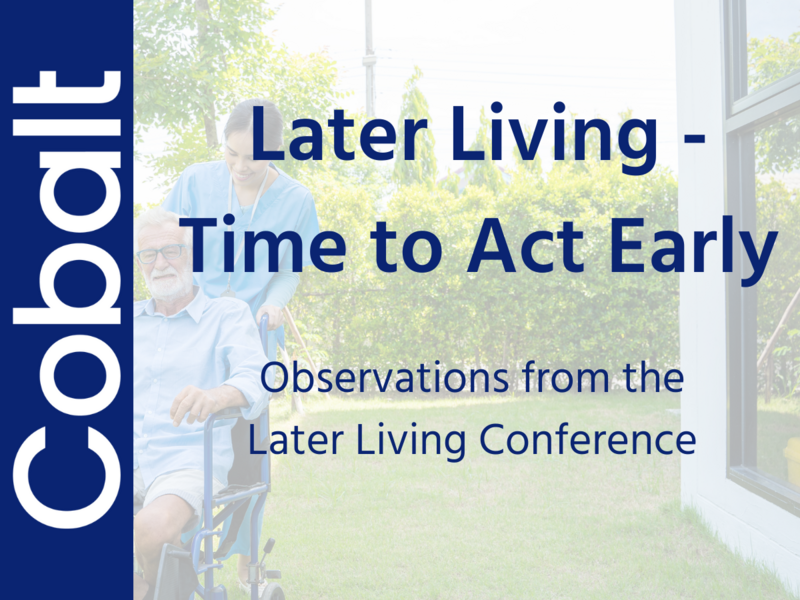
Article posted by on Apr 10, 2024
Currently, only 3% of new housing being built in the UK is designed for Later Living, with 30,000-50,000 more homes needed to satisfy this growing, ageing population – that also happen to be the wealthiest generation of the 67 million people in the UK today. This statistic from Tom Scaife (Knight Frank) was one of many highlighted at the Later Living Conference.
In addition to the above and the predicted growth of those living longer from the wealthy Baby Boomer generation, investors see an opportunity to diversify their portfolios into this space. Later Living features a customer base with longer leases, and some assurance that they’ll remain in the accommodation for a substantial period, that can provide reliable, long-term earning potential from their assets.
Some of the Cobalt team and I attended the Conference and wanted to summarise what is changing in the sector and the opportunity this provides for the built environment, from how we develop and plan these spaces to the build and management of such accommodation, and the key skills that are going to be needed as this sector further develops.
How can the property sector respond to the demand for Later Living housing?
Purely retirement-focused villages will be one way to fix this lack of housing, but offering truly specialist housing and creating diverse communities - featuring some student, some BTR, co-living, and for-sale accommodation, will see Later Living elements breed greater success.
With some businesses and charities already challenging how things are done (e.g. Tonic Housing with their LGBTQ+ community in London, with hopefully more soon), it seems that some of the main players are starting to sing from the same hymn sheet, listening more acutely to their residents to gain feedback (something cited by most at the Conference, including Ben Rosewall of Legal & General and Dan Madsen of Leisure Care) and collaborating with other living sectors as a result. There are an increasing number of innovators in the sector adapting to the needs with new inclusive design, and an increased focus on data-led insights too, to tell us what the residents maybe cannot.
Looking to a more established Later Living market, that of New Zealand, Michael Voges of ARCO (Associated Retirement Community Operators) suggested that there’s a school of thought that typically there are two stages of retirement. The first stage being when an individual or couple retires from work and still wants full independence and perhaps a smaller home aged 60+, to then a ‘second’ retirement, where one may need more assistance, aged 80+. There is an opportunity for the UK to begin to think like this, as Director of Wellbeing at Riverstone, Zoe Wyrko, pointed out at the Conference. Redefining the word ‘care’ (which is often attributed to a stigma of losing autonomy), and instead referring to it as ‘support to stay independent’, and reflecting this in the accommodation, provisions and activities offered by including gyms, greenspaces, and more in Later Living quarters, is something that planners need to be considering for the next generation moving into these homes.
The sector is far from fully matured (ironically!) and there is so much opportunity for innovation within it. Outside of the Conference, I have recently discussed with contacts at other social enterprises including Birchgrove and Hybr about their plans to create intergenerational living hubs - homes for students, key workers and retirees in one community in Mill Hill, North London - which will provide affordable high-quality accommodation for all. Developments like this could solve some of society’s problems, and shows that through ingenuity and collaboration, we can indeed, achieve more.
What does this mean for recruitment in Later Living?
Simply put, candidates will need to move with the needs of the sector. We’ve already seen how a broader understanding of the real estate spectrum is needed by employees in 2024 as assets are repositioned. Candidates that have this appreciation will see the greatest success in terms of their career development.
Within the planning and development space, greater importance will be put on the intersectionality of different living assets, and how an appreciation and experience level within one type of living asset will closely align with another, like Later Living. Understanding how local authorities have responded to different living types will be important, as will bringing together inclusive design into the process as early as possible.
Within the property management space there will be an increased emphasis on H&S (Building Safety Act) requirements, particularly with regard to Fire Safety. Equally, people who are customer-service savvy, with the ability to understand the true needs of their customers within the space and build a great service delivery model, will see the greatest success in the space.
We’re working with a number of outstanding candidates across the built environment that are at the forefront of this change – experienced land, development and facilities/building managers that are spearheading their spaces as the real estate sector evolves.
Find out more about the calibre of candidates we’re working with:
Kate Peers-McQueen, Associate Director, Residential Development and Town Planning – kpeersmcqueen@cobaltrecruitment.com / +44 (0)754 545 5380
Chris Sycamore, Associate Director, Facilities & Residential Management -csycamore@cobaltrecruitment.com / +44 (0)20 7478 2544
See our latest roles available across Real Estate and Construction here.